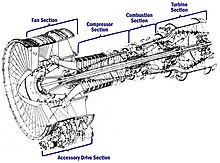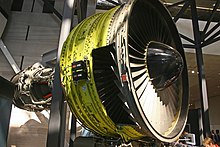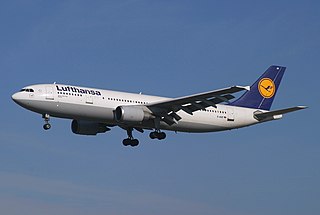
The Airbus A300 is Airbus's first production aircraft and the world's first twin-engine, double-aisle (wide-body) airliner, developed and manufactured by Airbus from 1971 to 2007.

The Airbus A310 is a wide-body aircraft, designed and manufactured by Airbus Industrie, then a consortium of European aerospace manufacturers. Airbus had identified a demand for an aircraft smaller than the A300, the first twin-jet wide-body. On 7 July 1978, the A310 was launched with orders from Swissair and Lufthansa. On 3 April 1982, the first prototype conducted its maiden flight, and the A310 received its type certificate on 11 March 1983.

The Airbus A330 is a wide-body aircraft developed and produced by Airbus. Airbus conceived several derivatives of the A300, its first airliner from the mid-1970s. Then the company began development on the A330 twinjet in parallel with the A340 quadjet and launched both designs with their first orders in June 1987. The A330-300, the first variant, took its maiden flight in November 1992 and entered service with Air Inter in January 1994. The slightly shorter A330-200 variant followed in 1998.
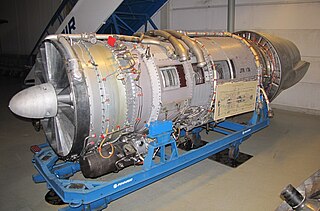
The Pratt & Whitney JT8D is a low-bypass turbofan engine introduced by Pratt & Whitney in February 1963 with the inaugural flight of the Boeing 727. It was a modification of the Pratt & Whitney J52 turbojet engine which powered the US Navy A-6 Intruder and A-4 Skyhawk attack aircraft. Eight models comprise the JT8D standard engine family, covering the thrust range from 12,250 to 17,400 pounds-force, and power the 727, 737-100/200, and DC-9. The updated JT8D-200 family, covering the 18,900 to 21,000 pounds-force, powers the MD-80 and re-engined Super 27 aircraft. The JT8D was built under license in Sweden as the Volvo RM8, a redesigned afterburning derivative for the Saab 37 Viggen fighter. Pratt & Whitney also sells static versions for powerplant and ship propulsion as the FT8.

The Pratt & Whitney JT9D engine was the first high bypass ratio jet engine to power a wide-body airliner. Its initial application was the Boeing 747-100, the original "Jumbo Jet". It was Pratt & Whitney's first high-bypass-ratio turbofan.

The Pratt & Whitney PW4000 is a family of dual-spool, axial-flow, high-bypass turbofan aircraft engines produced by Pratt & Whitney as the successor to the JT9D. It was first run in April 1984, was FAA certified in July 1986, and was introduced in June 1987. With thrust ranging from 50,000 to 99,040 lbf, it is used on many wide-body aircraft.

The General Electric GE90 is a family of high-bypass turbofan aircraft engines built by GE Aviation for the Boeing 777, with thrust ratings from 81,000 to 115,000 pounds-force. It entered service with British Airways in November 1995. It is one of three options for the 777-200, -200ER, and -300 versions, and the exclusive engine of the -200LR, -300ER, and 777F. It was the largest jet engine, until being surpassed in January 2020 by its successor, the 110,000 lbf (490 kN) GE9X, which has a 6-inch (15 cm) larger diameter fan. However, the GE90-115B, the most recent variant, is rated for a higher thrust than the GE9X.

The Rolls-Royce Trent is a family of high-bypass turbofans produced by Rolls-Royce. It continues the three spool architecture of the RB211 with a maximum thrust ranging from 61,900 to 97,000 lbf . Launched as the RB-211-524L in June 1988, the prototype first ran in August 1990. Its first variant is the Trent 700 introduced on the Airbus A330 in March 1995, then the Trent 800 for the Boeing 777 (1996), the Trent 500 for the A340 (2002), the Trent 900 for the A380 (2007), the Trent 1000 for the Boeing 787 (2011), the Trent XWB for the A350 (2015), and the Trent 7000 for the A330neo (2018). It has also marine and industrial variants like the RR MT30.

The CFM International CFM56 series is a Franco-American family of high-bypass turbofan aircraft engines made by CFM International (CFMI), with a thrust range of 18,500 to 34,000 lbf. CFMI is a 50–50 joint-owned company of Safran Aircraft Engines of France, and GE Aerospace (GE) of the United States. GE produces the high-pressure compressor, combustor, and high-pressure turbine, Safran manufactures the fan, gearbox, exhaust and the low-pressure turbine, and some components are made by Avio of Italy and Honeywell from the US. Both companies have their own final assembly line, GE in Evendale, Ohio, and Safran in Villaroche, France. The engine initially had extremely slow sales but has gone on to become the most used turbofan aircraft engine in the world.

The Pratt & Whitney PW2000, also known by the military designation F117 and initially referred to as the JT10D, is a series of high-bypass turbofan aircraft engines with a thrust range from 37,000 to 43,000 lbf. Built by Pratt & Whitney, they were designed for the Boeing 757. As a 757 powerplant, these engines compete with the Rolls-Royce RB211.

The Engine Alliance GP7000 is a turbofan jet engine manufactured by Engine Alliance, a joint venture between General Electric and Pratt & Whitney. It is one of the powerplant options available for the Airbus A380, along with the Rolls-Royce Trent 900.

The General Electric TF39 is a high-bypass turbofan engine that was developed to power the Lockheed C-5 Galaxy. The TF39 was the first high-power, high-bypass jet engine developed. The TF39 was further developed into the CF6 series of engines, and formed the basis of the LM2500 and LM6000 marine and industrial gas turbine. On September 7, 2017, the last active C-5A powered with TF39 engines made its final flight to Davis-Monthan Air Force Base for retirement. The TF39 was effectively retired, and all remaining active C-5 Galaxys are now powered by F138 engines.
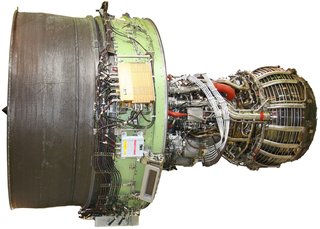
The General Electric GEnx is an advanced dual rotor, axial flow, high-bypass turbofan jet engine in production by GE Aerospace for the Boeing 747-8 and 787. The GEnx succeeded the CF6 in GE's product line.

The General Electric LM6000 is a turboshaft aeroderivative gas turbine engine. The LM6000 is derived from the CF6-80C2 aircraft turbofan. It has additions and modifications designed to make it more suitable for marine propulsion, industrial power generation, and marine power generation use. These include an expanded turbine section to convert thrust into shaft power, supports and struts for mounting on a steel or concrete deck, and reworked controls packages for power generation. It has found wide use including peaking power plants, fast ferries and high speed cargo ship applications.

The Rolls-Royce Trent 500 is a high-bypass turbofan produced by Rolls-Royce to power the larger A340-500/600 variants. It was selected in June 1997, first ran in May 1999, first flew in June 2000, and achieved certification on 15 December 2000. It entered service in July 2002 and 524 engines were delivered on-wing until the A340 production ended in 2012.

The Rolls-Royce Trent 700 is a high-bypass turbofan aircraft engine produced by Rolls-Royce plc to power the Airbus A330. Rolls-Royce was studying a RB211 development for the A330 at its launch in June 1987. It was first selected by Cathay Pacific in April 1989, first ran in summer 1992, was certified in January 1994 and was put into service on 24 March 1995. Keeping the characteristic three-shaft architecture of the RB211, it is the first variant of the Trent family. With its 97.4 in (247 cm) fan for a 5:1 bypass ratio, it produces 300.3 to 316.3 kN of thrust and reaches an overall pressure ratio of 36:1. It competes with the General Electric CF6-80E1 and the PW4000 to power the A330.

The Rolls-Royce Trent 800 is a high-bypass turbofan produced by Rolls-Royce plc, one of the engine options for the early Boeing 777 variants. Launched in September 1991, it first ran in September 1993, was granted EASA certification on 27 January 1995, and entered service in 1996. It reached a 40% market share, ahead of the competing PW4000 and GE90, and the last Trent 800-powered 777 was delivered in 2010. The Trent 800 has the Trent family three shaft architecture, with a 280 cm (110 in) fan. With a 6.4:1 bypass ratio and an overall pressure ratio reaching 40.7:1, it generates up to 413.4 kN of thrust.

A trijet is a jet aircraft powered by three jet engines. In general, passenger airline trijets are considered to be second-generation jet airliners, due to their innovative engine locations, in addition to the advancement of turbofan technology. Trijets are more efficient than quadjets, but not as efficient as twinjets, which replaced trijets as larger and more reliable turbofan engines became available.
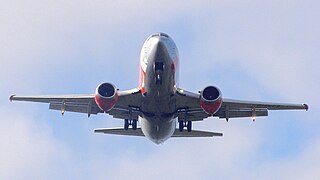
A twinjet or twin-engine jet is a jet aircraft powered by two engines. A twinjet is able to fly well enough to land with a single working engine, making it safer than a single-engine aircraft in the event of failure of an engine. Fuel efficiency of a twinjet is better than that of aircraft with more engines. These considerations have led to the widespread use of aircraft of all types with twin engines, including airliners, fixed-wing military aircraft, and others.


